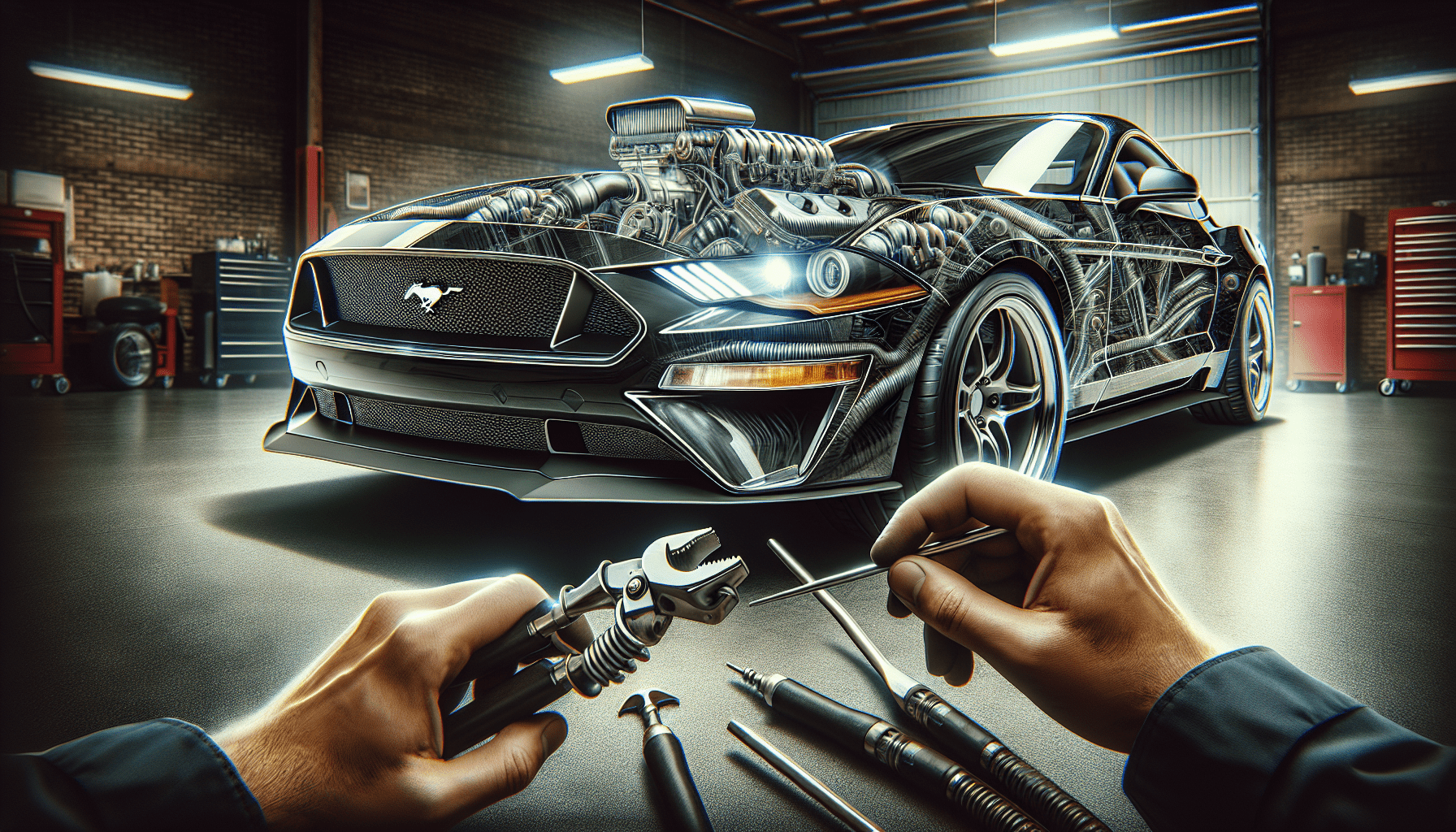Maintaining and caring for your Ford Performance vehicle is crucial to ensure its longevity and optimal performance. From regular maintenance tasks like checking tire pressure and oil changes, to more specialized care such as monitoring performance upgrades and avoiding aggressive driving, this article will guide you through the essential steps to keep your Ford Performance vehicle at its best. Whether you are a new owner or a long-time enthusiast, understanding these strategies will help you enjoy the exhilarating power and superior handling of your Ford Performance vehicle for years to come.
Regular Maintenance
Oil Changes
Regular oil changes are essential for maintaining the health and performance of your Ford performance vehicle. Clean oil helps to lubricate the engine, reduce friction, and prevent wear and tear on engine components. It is recommended to change the oil every 5,000 to 7,500 miles or as recommended by your vehicle’s manufacturer. Always use the recommended type and grade of oil for your specific model.
Fluid Checks
Regularly checking and topping up the various fluids in your Ford performance vehicle is crucial for its smooth operation. This includes fluids such as coolant, brake fluid, power steering fluid, and transmission fluid. Proper levels of these fluids ensure that key systems within your vehicle, like the cooling system and brakes, are functioning optimally.
Filter Replacements
Replacing filters, such as the air filter and fuel filter, on a regular basis ensures that your Ford performance vehicle’s engine is protected from contaminants that can negatively impact performance. Air filters should typically be replaced every 12,000 to 15,000 miles, while fuel filters are often replaced every 30,000 to 60,000 miles. Regularly inspecting and replacing these filters will help maintain the overall health of your engine.
Tire Care
Tire Rotation
Regularly rotating your tires helps to ensure even wear and extends their lifespan. Proper tire rotation patterns vary depending on your vehicle’s drivetrain. However, a general guideline is to rotate your tires every 5,000 to 7,000 miles. This will help maintain optimal traction, improve handling, and maximize the longevity of your tires.
Tire Pressure
Maintaining the correct tire pressure is crucial for both performance and safety. Improperly inflated tires can lead to decreased fuel efficiency, compromised handling, and increased risk of blowouts. Check your tire pressure regularly and ensure that it matches the recommended levels provided in your vehicle’s owner’s manual or on the tire placard located on the driver’s side door jamb.
Tread Depth
Regularly inspecting the tread depth of your tires is vital for maintaining traction on the road. As tires wear down, their ability to grip the road diminishes, especially in wet or snowy conditions. Use a tread depth gauge or the “penny test” to determine if your tires have sufficient tread depth. If the tread depth falls below 2/32 of an inch, it is time to replace your tires.

Brake System Maintenance
Brake Fluid Flush
Periodically flushing the brake fluid in your Ford performance vehicle is essential for maintaining proper brake function. Brake fluid absorbs moisture over time, which can lead to decreased performance and even brake system failure. It is generally recommended to have your brake fluid flushed every 30,000 miles or as advised in your vehicle’s owner’s manual.
Brake Pad Inspection
Regularly inspecting the brake pads in your vehicle can help identify signs of wear and ensure that they are functioning correctly. Squeaking or grinding noises when applying the brakes may indicate that the brake pads are worn and need replacing. Inspect the brake pads visually, and if they appear too thin or worn down, it is time to have them replaced.
Rotor Replacement
Inspecting the condition of your brake rotors is crucial for optimal braking performance. Over time, rotors can become warped or worn, leading to decreased stopping power. If you notice pulsating or vibrating sensations when applying the brakes, it may be an indication that the rotors need to be replaced. Consult a professional for a thorough inspection and to determine if rotor replacement is necessary.
Engine Care
Spark Plug Replacement
Regularly replacing your spark plugs is essential for the proper functioning of your Ford performance vehicle’s engine. Spark plugs play a crucial role in igniting the air-fuel mixture in the combustion chamber. Over time, spark plugs can become fouled or worn, leading to decreased engine performance and fuel efficiency. Replace the spark plugs according to the recommended interval provided in your vehicle’s owner’s manual.
Air Filter Cleaning/Replacement
The air filter in your Ford performance vehicle prevents dirt, dust, and other contaminants from entering the engine. Over time, the air filter can become clogged, restricting airflow and decreasing engine performance. Regularly inspect and clean the air filter, and if it is excessively dirty or damaged, replace it with a new one.
Coolant Check
Regularly checking the coolant level and quality in your Ford performance vehicle is essential for maintaining optimal engine temperature. Insufficient coolant levels or a compromised cooling system can lead to engine overheating, which can cause severe damage. Check the coolant level regularly and inspect for any signs of leaks or contamination. Replace the coolant as recommended in your vehicle’s owner’s manual.

Battery Maintenance
Battery Inspection
Regularly inspecting the battery in your Ford performance vehicle is essential for ensuring proper starting power. Look for signs of corrosion or damage on the battery terminals and cables. Corrosion can limit the flow of electricity and affect the battery’s performance. If you notice any issues, clean the terminals and cables or consult a professional for further inspection.
Terminal Cleaning
Cleaning the battery terminals is an important part of battery maintenance. Corrosion can build up on the terminals, hindering the flow of electricity. Use a battery terminal cleaner or a mixture of baking soda and water to clean the terminals. Be sure to disconnect the negative terminal first and reconnect it last to avoid electrical hazards.
Battery Replacement
Car batteries have a limited lifespan, typically ranging from 3 to 5 years. If you notice signs of a weak battery, such as slow cranking or difficulty starting, it may be time to replace it. Consult your vehicle’s owner’s manual or a professional to ensure you select the correct battery for your Ford performance vehicle.
Exterior Cleaning
Car Wash
Regularly washing your Ford performance vehicle helps to remove dirt, grime, and road salt that can accumulate on the exterior surface. Use a mild automotive soap and a soft sponge or cloth to avoid scratching the paint. Wash the car thoroughly, including the wheels and undercarriage, and rinse with clean water to maintain the vehicle’s appearance and prevent corrosion.
Waxing
After washing your vehicle, applying a coat of wax helps protect the paint and provides a glossy finish. Waxing creates a barrier between the paint and environmental contaminants, such as UV rays and pollutants. Choose a high-quality automotive wax and apply it according to the manufacturer’s instructions for best results.
Paint Protection
To further protect the paint on your Ford performance vehicle, consider applying a paint protection film or ceramic coating. Paint protection films provide an additional layer of defense against scratches, chips, and fading caused by environmental factors. Ceramic coatings offer long-lasting protection and a high level of resistance to dirt, UV rays, and chemical contaminants.
Interior Cleaning
Vacuuming
Regularly vacuuming the interior of your Ford performance vehicle helps to remove dirt, dust, and debris that can accumulate on the seats, carpet, and floor mats. Use a vacuum cleaner with upholstery attachments to reach into crevices and corners. Pay special attention to areas where dirt tends to accumulate, such as the footwells and under the seats.
Dash Cleaning
Cleaning the dashboard and other interior surfaces not only keeps your Ford performance vehicle looking great but also helps to protect the materials from damage. Use a mild interior cleaner and a microfiber cloth to wipe down the dashboard, console, and door panels. Avoid using harsh chemicals or abrasive materials that can cause discoloration or scratches.
Leather Treatment
If your Ford performance vehicle has a leather interior, regular maintenance is necessary to keep it looking and feeling its best. Use a leather cleaner and conditioner specifically designed for automotive use to clean and moisturize the leather surfaces. This helps to prevent drying, cracking, and fading, prolonging the life of your leather seats and trim.
Performance Upgrades
Intake System Upgrade
Upgrading the intake system in your Ford performance vehicle can enhance power and throttle response. Cold air intakes, for example, can increase the amount of cool air entering the engine, resulting in improved combustion and increased horsepower. Consult with a reputable performance shop or refer to your vehicle’s specific recommendations for the best intake system upgrade for your needs.
Exhaust System Upgrade
Upgrading the exhaust system can improve both performance and sound. Performance exhaust systems are designed to reduce restrictions and optimize exhaust flow. This enhances engine efficiency and can lead to improved horsepower and torque. Additionally, aftermarket exhaust systems can provide a more aggressive and sporty exhaust note. Research different options and seek professional advice for the best exhaust system upgrade for your Ford performance vehicle.
Suspension Enhancements
Enhancing your Ford performance vehicle’s suspension system can greatly improve handling and overall driving experience. Upgrading suspension components, such as sway bars, struts, or coilovers, can provide better cornering ability, reduced body roll, and improved stability. Consider your driving style and objectives when choosing suspension enhancements, as certain upgrades may be more suitable for track-focused performance or everyday driving.
Driving Tips
Avoid Hard Acceleration
While Ford performance vehicles are designed to deliver thrilling acceleration, excessive hard acceleration can put stress on the engine and other drivetrain components. It is important to balance spirited driving with responsible vehicle operation. Avoid frequent aggressive acceleration and opt for smooth and controlled driving to prolong the life of your vehicle.
Avoid Excessive Idling
Letting your Ford performance vehicle idle for extended periods wastes fuel and contributes to unnecessary wear on the engine. If you anticipate being stationary for more than a few minutes, such as at a long stoplight or in heavy traffic, consider turning off the engine. This not only reduces fuel consumption but also helps reduce emissions and extends the life of your engine.
Avoid Potholes
Potholes can cause significant damage to your Ford performance vehicle’s suspension, tires, and wheels. Whenever possible, try to avoid potholes by anticipating their presence and adjusting your driving accordingly. If you cannot avoid a pothole, slow down to reduce the impact and lessen the risk of damage. Regularly inspect your vehicle after encountering potholes for any signs of potential issues.
Storage Tips
Proper Storage Techniques
If you need to store your Ford performance vehicle for an extended period, it is important to take the necessary precautions to protect it. Store the vehicle in a cool, dry, and well-ventilated space to prevent moisture buildup and corrosion. If possible, use a car cover to protect the exterior from dust and debris. Refer to your vehicle’s owner’s manual for any specific storage guidelines.
Battery Maintenance
Before storing your vehicle, it is important to properly maintain the battery to avoid potential issues. Ensure that the battery is fully charged before storage and consider using a battery tender or maintainer to keep it charged during the storage period. This helps prevent the battery from losing its charge and ensures that your vehicle will start up smoothly when you’re ready to use it again.
Tire Pressure Monitoring
When storing your Ford performance vehicle, pay attention to the tire pressure. Over time, tires can lose air pressure, which can lead to flat spots and potential damage. Inflate the tires to the recommended pressure levels before storage and periodically check the pressure during the storage period. If necessary, top up the pressure to the proper levels to maintain tire health.
By following these maintenance and care tips for your Ford performance vehicle, you can ensure that it continues to deliver optimal performance, longevity, and an enjoyable driving experience. Regularly scheduled maintenance, proper cleaning, and responsible driving practices will help keep your vehicle in top condition for years to come. Remember to always consult your vehicle’s owner’s manual and seek professional assistance when necessary. Happy motoring!


